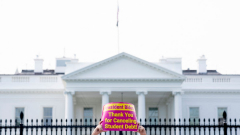
- The White House projects Biden’s student loan debt cancellation will cost about $24 billion per year.
- Combining new reforms, a Penn Wharton analysis projects Biden’s overall plan could top $1 trillion.
- The White House project assumes that only 75% of eligible borrowers will participate.
WASHINGTON — The White House said Friday that President Joe Biden’s action to cancel student loan debt for millions of borrowers will cost the federal government $240 billion over the next decade after refusing to give a cost estimate earlier in the week.
But other outside analysts said the price tag is much higher – especially when factoring in a new income-based loan repayment model outlined by the president.
The Biden administration projects the move to cancel up to $20,000 in student loan debt for Pell Grant recipients, and $10,000 for other borrowers, will reduce loan repayments collected by the government by an average of $24 billion annually for 10 years, said Bharat Ramamurti, deputy director of the National Economic Council.
The estimate, which the White House declined to make in the immediate days after Biden’s Wednesday student loan announcement, comes as Republicans have attacked the actions as an unfunded “bailout” of wealthy college-goers at the expense of Americans who lack college degrees.
More: ‘Debt and no degree’: Biden cancels as much as $20K in student loan debt: Recap
The White House’s projection is based on the assumption that 75% of eligible Americans with federal student loan debt participate, matching the ratio of similar federal programs. Borrowers will have to submit forms proving their eligibility for their debt to be canceled.
Ramamurti said the $24 billion annually represents just 1.5% of the projected $1.7 trillion deficit reduction the administration is projecting for the current fiscal year. As a result, he said the White House considers the plan “fully paid for.”
“It’s paid for and far more by the amount of deficit reduction that we’re already on track for this year,” Ramamurti said. “We’re using a portion of that – a very small portion of it – to provide relief to middle-class families.”
An official budgetary “score” – or projection – is expected from the Department of Education and Office of Budget Management in the coming weeks.
The Wharton School of the University of Pennsylvania released an analysis that had very different findings. Just Biden’s debt cancelation alone will cost up to $519 billion over 10 years, the study found, and the overall cost could rise to more than $1 trillion when factoring in other of Biden’s components such as new income-driven loan payments.
Ramamurti rejected those findings, noting the Penn Wharton analysis assumes 100% participation and doesn’t take into account millions of borrowers in default haven’t been paying the government. He said $450 billion-plus in additional costs tied in the study to new income-based repayments, such as capping payments at 5% of a borrower’s income, were “speculative.”
The non-profit Committee for a Responsible Federal Budget estimated a total cost of $500 billion that includes $360 billion for the debt cancelation, $120 billion for income-driven loan repayments and $20 billion for extending a pandemic-era moratorium on payments through Dec. 31.
The White House has argued that the resumption of student loan payments after the moratorium ends will offset the risk of exacerbating 40-year high inflation. Ramamutri said the end of the moratorium will increase loan repayments to the government by about $48 billion a year. Monthly loan repayments to the government reduced from $6 billion to $2 billion during the two-year freeze on payments
More than 43 million Americans have federal student loan debt. To receive relief under Biden’s action, borrowers must earn less than $125,000 a year and reside in households earning less than $250,000. The majority of eligible borrowers are recipients of Pell Grants, which target low-income students.
More: Biden’s student debt forgiveness is a potential midterm boon for Democrats — and a major gamble
About 90% of borrowers who will receive student loan debt relief under Biden’s plan earn less than $75,000, according to





